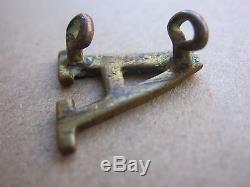Authentic WW1 ANZAC'A' Badge for Australian Imperial Force Service at Gallipoli








A uthentic / Original item for WW1 (as worn by Australian AIF members entitled for service at Gallipoli) - NOT REPRODUCTION. Dimensions / Size approximate h. See all sven (7) photographs which form most of the description for this listing. The badge will polish very well to its original brilliance. In 1917 it was announced that Gallipoli veterans would be entitled to wear a brass letter A for Anzac, on their unit colour patches.
It is understood that this idea was first suggested by General Gellibrand to General Godley early in 1916, and the badges first appeared later that year. The idea was well received by Anzac veterans who were proud to wear this token of honour they had achieved for the AIF in the 1915 campaign. In January 1918 the right to wear it was extended to service "on the islands of Lemnos, Imbros, and Tenedos, on the transports or hospital ships at or off Gallipoli or these islands or in the AIF line of communications units from Egypt". AIF orders authorised the wearing of a small badge in the form of the letter "A" on unit colour patches to denote that the wearer had taken part in the 1915 Gallipoli campaign.
It was later prescribed that the badge would be a brass letter three quarters inch high. A further order, in January 1918 extended the eligibility to service "on the islands of Lemnos, Imbros, and Tenedos, on the transports or hospital ships at or off Gallipoli or these islands or in the AIF line of communications units from Egypt". It is interesting to note that this final addition embraced the work of the Australian Army Nursing Service so that both men and women were acknowledged as "the Anzacs". The wearing of cloth colour patches on the sleeves of jackets was adopted in 1915 as the means of identifying units of the AIF shortly before Australian battalions began to be embarked for service on Gallipoli. The system was retained by the Australian Army after the war and remained in use during the Second World War.
Anzac veterans who were again serving in uniform in the latter period were again able to wear the Anzac "A". The Anzac badge has a hazy origin.Generals Gellibrand, Monash and Birdwood were among those variously given credit for its introduction. It seems most likely that the badge was the culmination of several ideas proposed in early 1916 to give recognition to the Australian veterans of Anzac. General Monash recorded one expression of such an idea when he paraded his brigade on the celebration of the first Anzac Day in 1916: Every man who had served on Gallipoli wore a blue ribbon on the right breast, and every man who, in addition, had taken part in the historic landing on 25 April 1915, wore a red ribbon also.
Alas how few of us are left who were entitled to wear both. General Birdwood himself a central figure on Anzac evidently favoured the idea of some permanent distinction to be worn by Anzac veterans.
In August 1916, he told the five Australian divisions that he had no objection to them adopting an "A" badge for their colour patches. There was a mixed reception to the suggestion. Those divisions containing most Anzacs (1st and 2nd Divisions) favoured the idea while the commanders of the 4th and 5th Divisions were initially opposed to it. It was left to each division to make its own arrangements about the provision and adoption of the badge. By November 1916, Monash (3rd Division) was able to report: "All who have a right to be called "Anzacs"among us are now wearing a metal "A on the colour patches on the sleeves.
In early 1917, convalescent Anzacs began to arrive in Australia wearing the Anzac "A" and the status of the badge, not previously seen in Australia, was queried. Finally deciding that formal adoption was necessary, AIF Order No. 937 (November 1917) authorised the badge for the whole force and ordered that it be supplied by Ordnance instead of regimental funds.
Subsequent orders made the wearing of the badge compulsory and clarified the eligibility rules. There had been some resentment to the adoption of the badge, particularly in the early years.Survivors of Pozieres and Mouquet Farm in 1916 had, quite reasonably, felt that their experiences were comparable to those of the Anzacs. The item "Authentic WW1 ANZAC'A' Badge for Australian Imperial Force Service at Gallipoli" is in sale since Monday, June 20, 2016. This item is in the category "Collectables\Militaria\1914 - 1918 (WWI)". The seller is "jnrdawn" and is located in Palmyra, WA. This item can be shipped worldwide.
- Authenticity: Original
- Country: Australia
- Campaign: World War I
- Product Type: Badges

